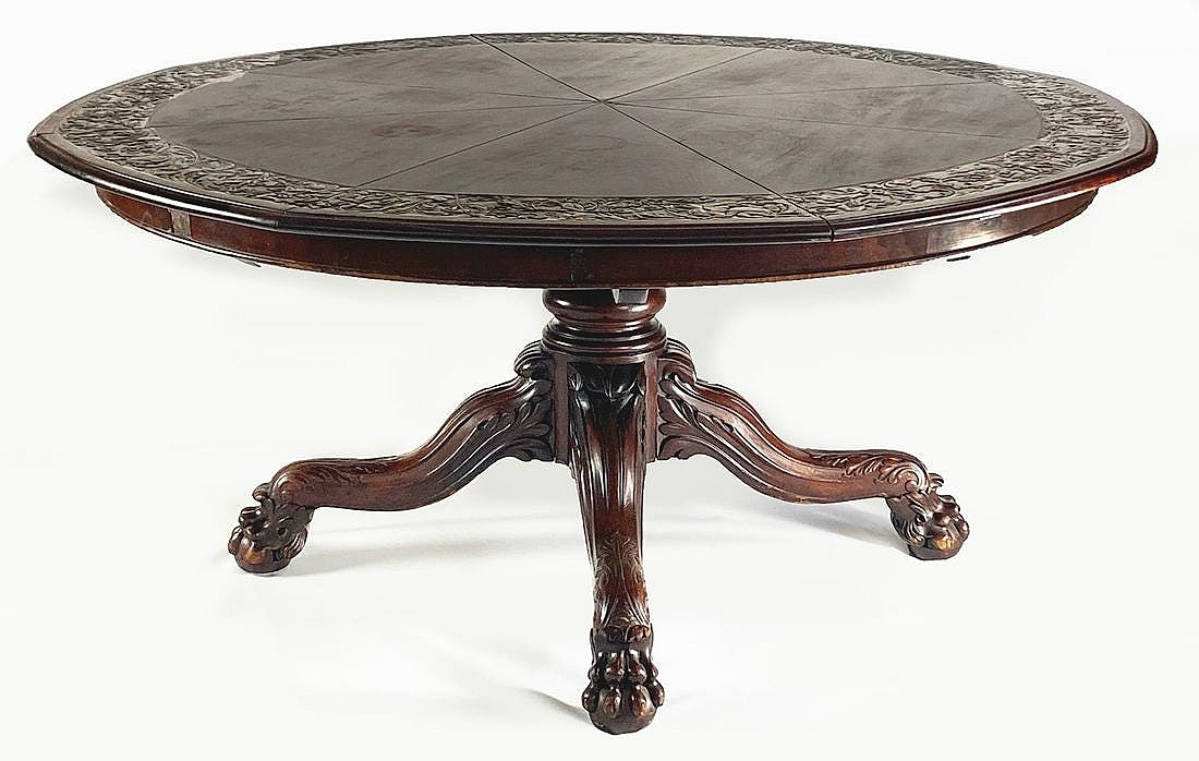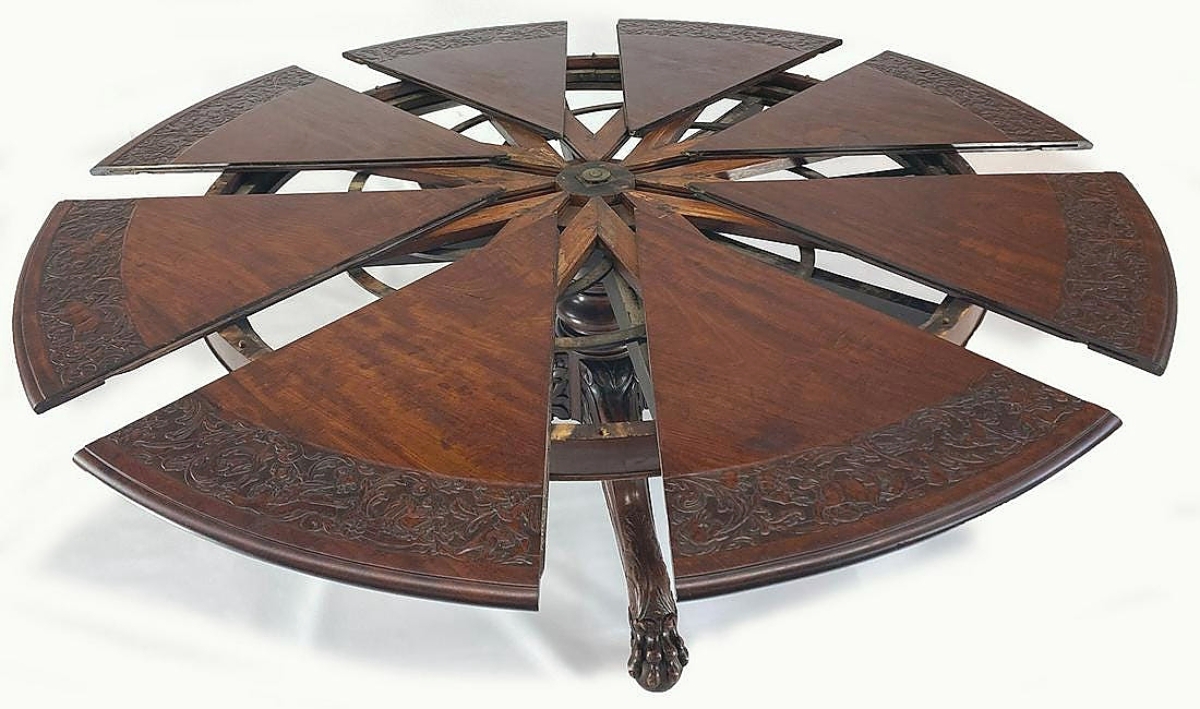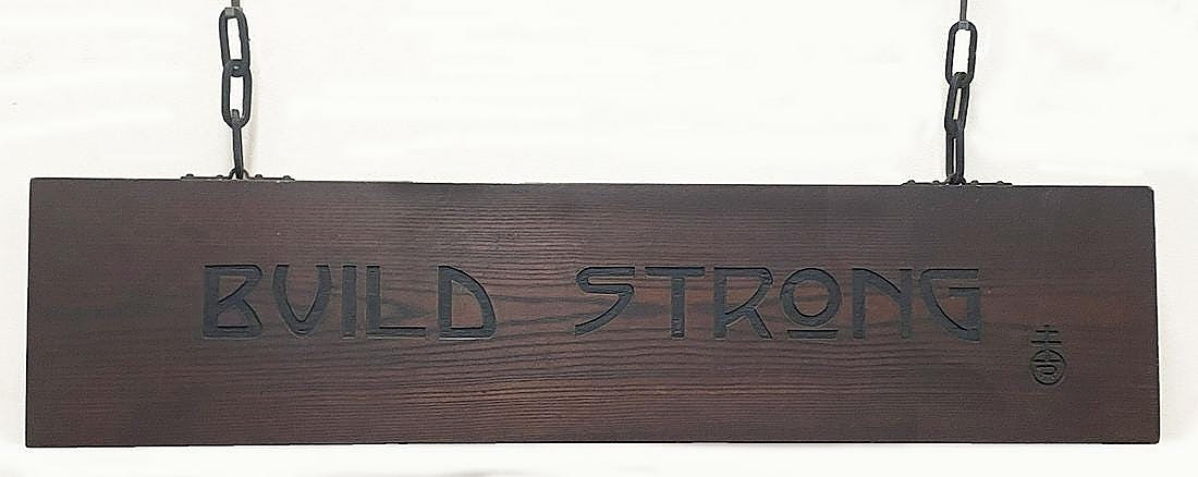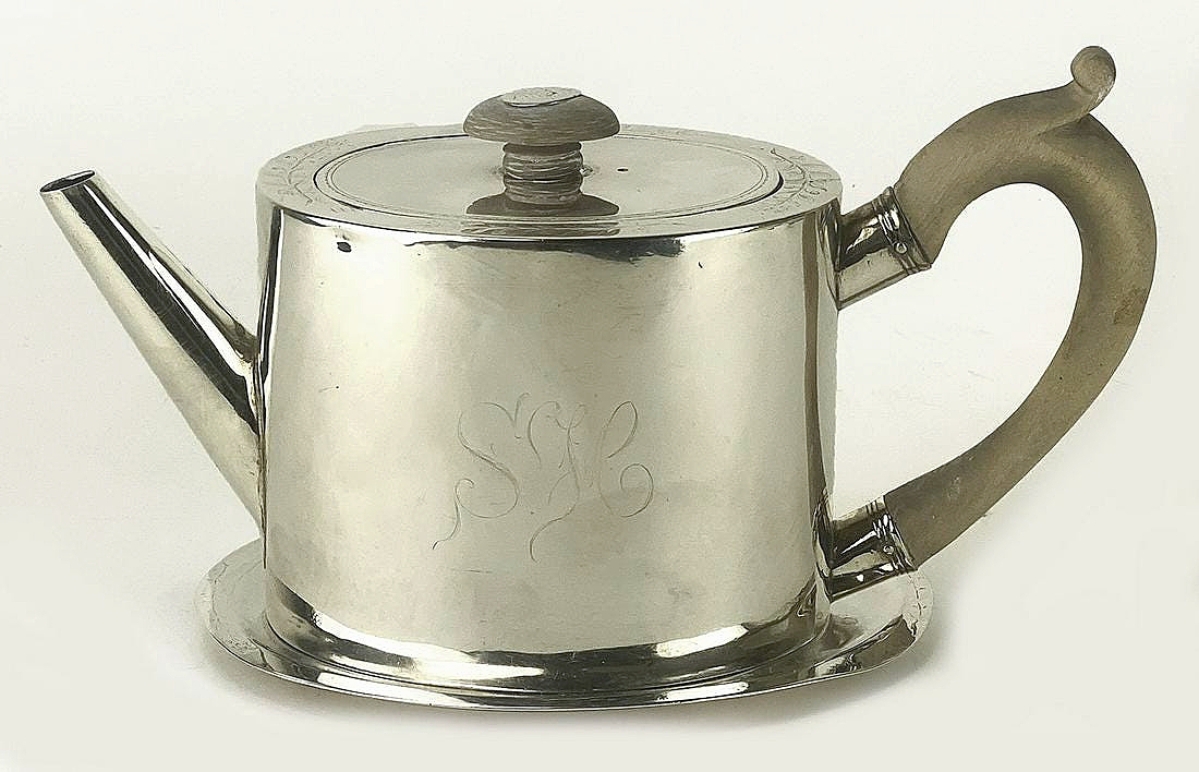
The large, round dining table made by Johnstone & Jeane’s, London, could be adjusted to three sizes, depending on whether it was used without leaves, or used with one of two sets of eight additional leaves of different sizes. Without leaves, it was 63 inches in diameter. It was the highest priced item in the sale, finishing at $56,288.
Review and Onsite Photos by Rick Russack, Additional Photos Courtesy CRN Auctions.
CAMBRIDGE, MASS. – Words like diverse or varied are understatements for CRN sales. Carl Nordblom and Karin Phillips assemble sales with American and European paintings; American, European and Asian furniture; Chinese, European and American ceramics; early silver; books; early glass; Oriental rugs and much more. The diversity and quality of the offerings can be seen in the fact that the five highest grossing lots in the sale were each of a different category: a piece of English furniture, an early American silver teapot, an Arts and Crafts sign, a pair of dueling pistols and a piece of American furniture. In line with pandemic regulations, about a dozen bidders were allowed in the gallery, numerous phone lines were in use, absentee bids were executed and internet bidding was available. This sale also included a collection of carousel horses and carvings, along with a very unusual, mechanical, expandable, carved dining table.
That large round dining table, as expected, brought the top price of the day, finishing at $56,288. That price may have been a very good buy as the internet records substantially higher prices and Nordblom commented during the preview, “I guarantee that whatever price it brings here, there’ll be plenty of room left in it.” The mahogany table was made about 1850 and labeled Johnstone & Jeane’s, London. The round table could be adjusted to three sizes, depending on whether it was used without leaves, or used with one of two sets of eight additional leaves of different sizes. Without leaves, it was 63 inches in diameter. If the owner wanted it to be able to accommodate more guests, easily rotating the top would fan it wide, allowing for leaves to be inserted. One set of leaves would expand it to 78 inches or, by use of another set of leaves, it could be expanded expand to 90 inches. The numbered leaves were stored in a separate, paneled box. The table mechanism was invented and patented by Theodore A.R. Jupe in 1835, and an example was shown at the 1851 Great Exhibition in London. The pedestal was heavily carved, terminating in claw and ball feet, and the border of the top was also carved with various animals, cupids and acanthus leaves. This particular example had descended in the Rockefeller family.

The Johnstone & Jeane’s tabletop easily rotated on its base to allow sets of leaves to be inserted, increasing the diameter to 78 inches or 90 inches, depending which set of eight additional leaves was put in place. The mechanism was patented in 1835, and tables using that mechanism are still being produced.
Recent auction prices have showed a renewed interest in some American furniture, and pieces in this sale reflected that trend. A maple and birch red painted Hepplewhite card table, with solid New Hampshire provenance, earned $14,640, nearly five times the estimate. With original surface, one drawer, a nicely scalloped apron and simple, square tapered legs, the table came from the Plummer home in Boscowen, N.H. It had remained in the family until 1943, when it was sold privately.
Also selling well over the estimate was an exceptional Eighteenth Century Rhode Island braced-back, fan-back Windsor side chair, described as having original paint. With an unusual boldly shaped crest and turned splayed legs, it sold for $10,370. An identical chair had been owned by dealers David Schorsch and Eileen Smiles. An article in this publication from the 1980s stated: “The braced-back Windsor side chair from coastal Connecticut or Rhode Island is one of only three known. Schorsch called it a masterpiece and priced it at $75,000.” Continuing the trend, a Boston Sheraton mahogany inlaid bowfront server, cataloged as Seymour school, realized $9,150.
It wasn’t only early American furniture that did well. Two pieces of Stickley also did well, and a Roycrofters trade sign was the second highest priced item in the sale. A signed Gustav Stickley oak fall front desk with original copper hinges and hardware reached $10,370. Of heavy, quartersawn oak, it had a red mark on the back and an interior with several compartments. Another Stickley piece, this one an unmarked bookcase with the firm’s distinctive Onandaga finish sold for $6,100. It was described as “circa 1903, number. 550, unmarked L & J.G. Stickley, in untouched condition with rich color, gallery to top, pair of glazed doors, copper hardware, and keyed tenons.” The 42-inch split log Roycrofters sign, with original bark on the back, surprised all. It simply said, “Build Strong” on one side, included a wrought iron chain to hang it and sold for $25,620. Indicative of the wide range of styles that can be found at CRN sales was an elaborate neo-renaissance Milanese ebonized and inlaid three-part cabinet. It was attributed to Ferdinando Pagliano (1832-1899) and had overall bone inlay with hunt scenes, classical figures and scrolling foliage. More than 8 feet tall, it was a lot of furniture for an appropriate home. The selling price was $2,684.

Roycrofter signs usually sell in the $1/1,500 price range and that’s how this one was estimated. But those signs are usually on typical double-sided boards. However, the back of this one, worded “Build Strong,” was rough — the bark was still on it, and that drove the final price to $25,620.
Three of the top ten lots in the sale were silver. A circa 1790 Paul Revere Jr teapot with undertray topped the selection, finishing at $17,080. The teapot was marked with a monogram, and inscribed to Stephen Horton of Milton, Mass., who served in the Revolutionary War at the battle of Lexington and elsewhere. The undertray was a gift from Stephen to his wife, Submit, and so inscribed, along with a date of 1790. The second highest priced piece of silver in the sale was a large ewer made almost 100 years later by Tiffany. The deeply engraved, ornate decoration included a mask of Bacchus, classical banding and grapevines. It was inscribed “Francis Bacon From His Grateful Friend Jared Linsly June 1887.” The ewer was 18½ inches tall; it weighed 78.6 troy ounces and sold for $12,200. Rounding out the three lots was another piece from that time period, a Boston Aesthetic Movement sterling silver repousse water pitcher made by Kennard and Jenks, which sold for $9,760, well over the estimate.
CRN sales always start with a selection of paintings, and this one was no exception. The first lot was an Antonio Jacobsen (1850-1921) painting of the Red Star line sail/steamer Belgenland in stormy seas, signed and dated 1887. The ship had been built by the Barrow Shipbuilding Company in 1878. The ship was scrapped in 1906, and the painting sold for $5,490. Bringing the same price was a moody landscape by French painter Hippolyte Camille Delpy (1842-1910). When, during the preview, Nordblom was asked which was his personal favorite item in the sale, he pointed to an unsigned, late Nineteenth Century painting of a young boy in a baseball uniform holding a bat. He said, ‘It just reminds me of when I was a little kid.” Bidders liked it, too, and it ended up at $4,270.
A sizeable collection of carousel horses and carvings came from a Baltimore woman who was donating the proceeds of her collection to animal welfare charities. Some pieces had been professionally repainted and restored, and some were not. In the latter category, and bringing the highest individual price of the collection, was a circa 1890 heavily carved chariot side in the form of a griffin, carved and signed, G.A. Dentzel. It brought $4,880. A well-carved and professionally restored “Mexican” leaping horse by Muller, circa 1910, earned $3,660. Some of the repainted pieces did not interest bidders and were passed.

Inscribed to a soldier who fought at the battle of Lexington and other Revolutionary War battles, this circa 1790 Paul Revere Jr teapot with undertray realized $17,080. The teapot bore the monogram of Stephen Horton of Milton, Mass.
A few days after the sale, Nordblom said, “We did well. The Hepplewhite card table did well, the Roycrofters sign was a nice surprise, as were the dueling pistols. Phone and internet bidding was strong, with numerous new customers joining in. I think there were some very good buys – and that’s good for business. I’m looking forward to getting back to live sales, and I’m hoping that our next will be that way.”
Prices given include the buyer’s premium as stated by the auction house. For more information, www.crnauctions.com or 671-661-9582.





























